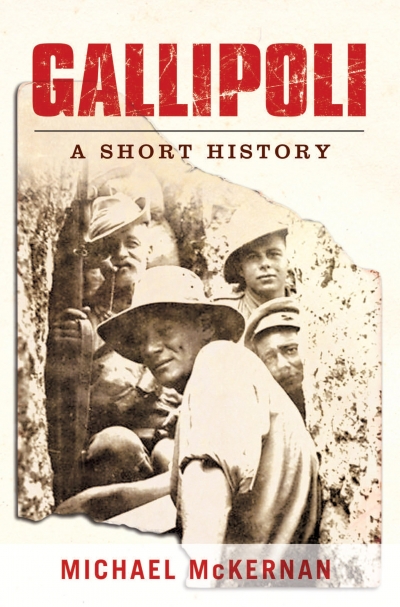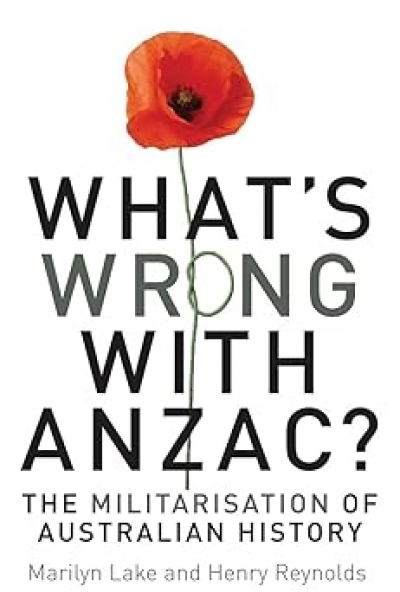Anzacs
Gallipoli: A Short History by Michael McKernan & Pozières: The Anzac Story by Scott Bennett
Michael McKernan states in his introduction to his short book on Gallipoli that he is dissatisfied with much writing on military history. He writes: ‘Military history is often presented as a thing of maps and statistics, a brutal narrative based on the deployments and motives of commanders with a score sheet of those who performed well and those who failed. In this book I have tried to go beyond that ... to show that somewhere for each life lost, there was long mourning and deep grief.'
... (read more)Anzac Legacies: Australians and the Aftermath of War edited by Martin Crotty and Marina Larsson
In their recent polemic What’s Wrong With Anzac? (2010), Marilyn Lake and Henry Reynolds lament the militarisation of Australian history epitomised by the profusion of memoirs and military history in bookshops. The authors make a fair point that war history and commemoration has drowned out other notable achievements and failings in our country’s past. But their broad brush sweeps away an important Australian tradition of critical reflection about war and society. If historians ignored Australians at war – as most did until the 1970s – there would be much more wrong with Anzac. Anzac Legacies, edited by Martin Crotty and Marina Larsson, is a compelling and insightful collection of carefully researched essays about the impact of war upon Australians and Australian society. It is a timely reminder that historians need to stay in the Anzac game, and can take it in challenging directions.
... (read more)What’s wrong with Anzac? The militarisation of Australian history by Marilyn Lake and Henry Reynolds (with Mark McKenna and Joy Damousi)
This is an important book that should be read by as wide a range of historians as possible. Some will find it totally agreeable, others will find it very disagreeable, while others will agree with some parts of the book but not all. It is a book not just about the ‘militarisation of Australian history’, but, perhaps more importantly, about how Australians see themselves in the world.
... (read more)Bardia: Myth, Reality and the Heirs of Anzac by Craig Stockings
With the sun’s morning rays glinting off their bayonets, the Australian soldiers rushed headlong towards the Italian fortress of Bardia in Libya. They sang as they advanced. Although there were isolated pockets of resistance, within hours the Australians had broken through the perimeter and Italian troops were beginning to surrender in their thousands. The capture of the supposedly ‘impenetrable’ fortress of Bardia in early January 1941 by the 6th Australian Infantry Division, fighting its first battle, was a major success that led to the capture of more than 40,000 Italian soldiers. The resounding victory by these sons of the original Anzacs was held to prove the inherent combat prowess of Australians. Major General Iven Mackay, the 6th Division’s commander, afterwards commented there was the notion ‘that the Australian is a born soldier and that, once given the weapons, he is alright’. Or so the myth goes.
... (read more)Shattered Anzacs: Living with the scars of war by Marina Larsson
One of the keenest childhood memories of David Meredith, narrator of George Johnston’s novel My Brother Jack (1964), is of the hall of his parents’ suburban home in Melbourne. It was full of prostheses, the artificial limbs of servicemen returned, maimed, from the Great War. The men are friends and former patients of Meredith’s parents. Her mother was a nurse, her father served in the First AIF. The scant historical regard that has been paid to these damaged men, and to their families, is rectified by Marina Larsson’s brilliant study of Shattered Anzacs. Her subject is the cohort of revenants who returned to Australia after the war – their bodies ruined, shell-shocked, infected with venereal disease and tuberculosis – and the families, institutions and government bureaucracies into whose hands they fell.
... (read more)According to Peter Rees’s introduction to The Other Anzacs, ‘at least 2498 nurses’ served overseas with the Australian Army Nursing Service during World War I, with about 720 in other units raised in Britain or privately sponsored. There were ‘at least 610 nurses’ in the New Zealand Army Nursing Service, and perhaps another 100 overseas. The criteria for acceptance were high. Nurses were required to have completed at least three years’ training in an approved hospital, to be aged between twenty-one and forty, and either single or widowed. The rules about marriage, however, were not always strictly observed, and as men sometimes fudged their age and other circumstances to get into the army, occasionally a woman may have disguised her marital status. But once in the Army Nursing Service, marriage usually meant resignation. If a nurse wished to keep working after she married, she had to join one of the private medical or hospital services that had come into being.
... (read more)Forty years ago, the proponents of the ‘new military history’ sought to extend our understanding of war and its impact by looking beyond the battlefield and by considering the social and cultural implications of armies and military activity. In the process, the best work added layer upon layer of complexity and nuance to the study of war in history, but over time it came to seem that this approach to military history was interested in anything and everything except war’s central concern: battle and purposeful, organised violence between groups and individuals. Peter Ewer has written a book that belongs to what some are now hailing as the ‘new new military history’, approaches that seek to integrate broader socio-cultural significance and individual experience with serious attention to the basic elements of war through the ages: battle and killing.
... (read more)After the phenomenal success of his Gallipoli (2001), Les Carlyon has turned his attention to the experience of Australian soldiers on the western front in the years 1916–18. Carlyon’s purpose in The Great War is clear: he wants to expand the national gaze that is transfixed on the military exploits at Anzac Cove, to include the lesser-known stories of the Australian Imperial Force (AIF) in France and Flanders. Five times as many Australians perished in the war’s main European theatre as had died fighting at Anzac Cove, but those post-Gallipoli soldiers tend to be accorded a second-rung status in the nation’s memory of the war. As Carlyon says: ‘There were so many, and they were ours, and we never really saw them.’
... (read more)Return to Gallipoli: Walking the battlefields of the great war by Bruce Scates
Why does ANZAC day seem more popular now than forty years ago? Despite the thinning ranks of veterans, attendances at dawn services in most capital cities are up, crowds at the marches are large and enthusiastic, numerous historians and former members of the armed services seem to be running profitable battle-field tour businesses, and the desire of young Australian backpackers to include Gallipoli (particularly on Anzac Day) in their itineraries increases every year. This popularity is even more remarkable given that in the 1970s and early 1980s Anzac Day was a source of controversy and dissent: anti-war protestors, Vietnam veterans who felt excluded from the national ethos, indigenous Australians who felt their wars were overlooked and feminists determined to highlight the problem of women raped in war, all saw this national day of commemoration as an occasion to press their cause. The RSL did not respond well to these attempts to undermine the sanctity of the day. The re-emergence of Anzac Day as a site for unity and cohesion, particularly amongst younger Australians, is intriguing.
... (read more)In earlier works, Russian-born historian Elena Govor has written of changing Russian perceptions of Australia between 1770 and 1919 and – in My Dark Brother (2000) – of a Russian-Aboriginal family. In her latest book, Russian Anzacs in Australian History, the canvas is broader. She investigates the third largest national group (after the British and Irish) to enlist in the First AIF. Her indefatigable and imaginative research has taken her on a ‘quest for the thousand Russian Anzacs’ who comprised ‘a virtual battalion’. More exactly, they amounted to one in every four male Russians who were in Australia at the outbreak of the Great War.
... (read more)










